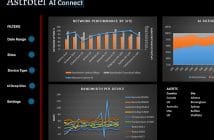
Competition in Australia’s multi-billion-dollar education sector is driving institutions to embrace data analytics and cloud-based solutions and to invest in collaborative and interactive learning technologies, edu-tech experts say.
Higher education institutions spend an estimated $1.9 billion on an array of ICT initiatives and this figure is growing at a healthy five per cent, year on year.
“It’s a big sector – education exports alone are worth an estimated $28 billion a year* and there are five million individuals currently enrolled in tertiary courses – but it’s quite fragmented,” says Mark Dougan, Managing Director at analyst firm, Frost and Sullivan Australia.
Speaking during a round-table discussion in Sydney on technology trends and cyber-security in Australia’s school, university and vocational education sectors, Dougan said institutions were increasingly using ICT as a differentiator in a market that’s competitive and becoming even more so.
“Institutions are investing in a range of applications, from learning management and student management systems through to business applications such as CRM and payroll which are customised to suit the unique requirements of the sector,” Dougan says.
Operating smarter
Peter Croft, APAC Managing Director at student management software vendor, Tribal Group, says schools have not been in the vanguard of new technology adoption, historically. Frontline spending priorities often result in ICT projects being deferred, despite their potential to deliver efficiency gains.
He says, “Implementing a new student management system across an institution is quite a big deal because there’s typically a lot of data to migrate and well-established practices that need to be modified.
“We’re finally seeing growing awareness among schools that going to the cloud offers significant advantages – doing so can reduce operational costs and remove the complications associated with managing platforms and systems internally.”
Croft says school leaders have latterly become aware of the potential to improve the productivity of their institutions through the use of data analytics.
“Education is a heavily measured sector but most of the measurement has occurred around student learning outcomes.
“Schools do run as businesses and like any business they have an interest in containing costs, operating as efficiently as they can and delivering value for money to parents and students. We’re seeing a large appetite for data analytics that can help schools understand where they can do things more smartly.”
Enhancing the learning experience
Jamie Davidson, ANZ Regional Sales Manager at Jamf, the management standard for the Apple ecosystem, says the use of mobile technology to deliver rich interactive learning experiences is helping schools and higher education providers differentiate themselves and improve learning outcomes for students.
“We’ve noted growing interest around the use of devices in the classroom, particularly in the STEM subjects in senior years,” Davidson says. “The Australian Government is investing heavily in STEM learning and Jamf believe iPads and the Apple ecosystem is the best way to support teachers and students in the classroom.
“Just purchasing iPads for classes is not going to cut it. Schools need to deploy those iPads with the content, apps and features that best support teachers to run their lessons.
“Schools should look to work with vendors who can help provide teachers with the tools that ensure an engaging, dynamic, well-supported STEM learning experience, globally.”
Collaboration in the classroom
Damian Aivaliotis, Strategy and Portfolio Manager – Digital Automation, at Ricoh, a leading provider of smart workplace technology, says the trend towards collaborative learning makes it incumbent upon institutions to explore tools and solutions which facilitate the practice.
“Activity based learning and group work are a feature of the higher education environment and technologies which make it easier for students and educators to connect and collaborate with one another can enhance the learning experience,”
Online and distance learning have become increasingly popular and need to be underpinned by workflow technologies which offer students a rich learning experience, irrespective of their location,” says Aivaliotis.
Keeping students and their data safe
Mark Sinclair, ANZ Regional Director at WatchGuard Technologies, a leader in advanced network security solutions, says educational institutions are grappling with similar security challenges to those being tackled by their counterparts in other sectors and they need to invest in security apace.
“With hacking and phishing on the rise, schools need to take a rigorous approach to threats, be vigilant against attacks and privacy breaches and use tools and technologies strategically, to safeguard their IT assets and school and student data.”
K-12 schools have a particularly responsibility to ensure the cyber-safety of their students and education is the key to minimising risk, Sinclair says.
“Ongoing education is a vital component of any cyber-security strategy and for educational institutions that means teaching staff and students to be more aware of the risks they face online and the things they can do to manage them.”
Round table participants agreed technology would play a key role in ensuring Australia’s education sector continues to meet the learning needs of students at all stages of their journeys.
“It’s also essential institutions remain focused on deriving maximum value from the public and private funding they receive and strategic investment in ICT projects and initiatives is part of that,” Dougan says.





